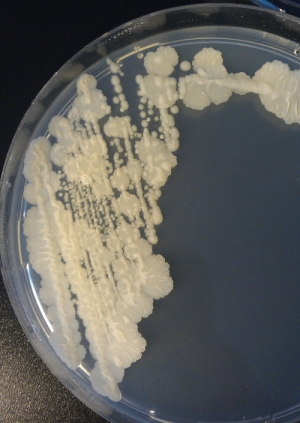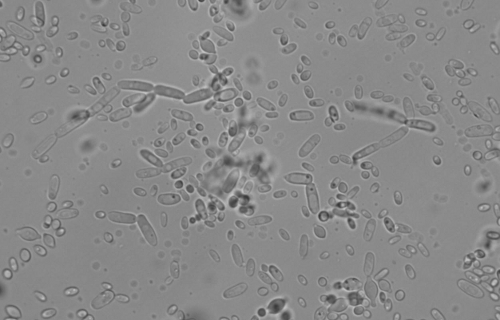Eureka, this is the second post in the pentade about some agar plates. The first post was about different dregs from commercial sour beers. This post is about a water kefir culture and a Lactobacillus starter. I made a Lactobacillus starter with sterile apple juice and dumped some acidified malt in there for a future Berliner Weisse. Made the starter a few days ago and it smells really sour. Lets get into the results.
Water kefir:
Plated my first water kefir on a Sabouraud plate to see what’s in there. I could observe only two kinds of colonies after three days of incubation:
– Off-white color, even, circular, glossy, convex, 2 mm diameter.
– White color, wavy, irregular, not glossy, flat, 10 mm diameter.
Since I had no idea what these colonies might be, I took a sample of each colony and did a microscopy analysis.
And now the really fun part begins: The circular colonies on the agar are no bacteria due to the size of the bugs. These must be some sort of yeasts. Maybe even more than one kind. But a kind of yeast that exists in a slender rather than in a circular form like brewers yeast (aka Saccaromyces). I have no idea what sort of yeast I have here.
And the wavy colonies look even more inhomogeneous than the circular colonies. But these are yeast cells as well due to the size. There are the slender ones again like in the picture above, and a kind of roundish smaller one as well. I have no idea what I got myself here. I expected to find some Lactobacillus bacteria on the plates since bacteria grow much faster than yeasts in general. But I could not find any. And no Lactobacillus on the microscopy samples as well. I guess that Sabouraud agar does not support the growth of Lactobacillus at all.
Comparing the two pictures gives me the impression that there are more than one different kind of yeasts. These results were very unexpected to me and I am quite fascinated what I got myself here.
Lactobacillus starter:
And for the starter: No sign of colony formation at all. Even after further incubation. This might prove that Sabouraud agar is indeed not a media to cultivate Lactobacillus bacteria. Unfortunately I do not have a microscopy picture of the Lactobacillus starter to show the bacteria.
Summary
What did I learn? First, Sabouraud might be unsuitable for cultivating Lactobacillus strains. Second of all, there are some sort of yeasts in the water kefir culture I could not identify further. Lets go back to the results from the first post about the dregs where I could observe only bacteria. The microscopy showed bacteria, Bacillus to be exactly. And I expected that the bacteria might be Lactobacillus or Acetobacter. As these results here showed that Lactobacillus might not grow on Sabouraud, I guess that the bacteria from the dregs must be Acetobacter then.
Did some research about the bugs in water kefir. Some sources state, that there are Candida strains or Kloeckera apiculata in there. I compared my pictures with published pictures of both yeasts and they looked very different to me.
I plated the different colonies on fresh Saboraud plates and will do further investigations.
If there is someone out there who can identify any of the bugs in the pictures, please comment below. And if someone has any ideas how/what to do next with the colonies, please let me know as well.
The next, third post about agar plates will be about some normal Saccaromyces strains.




HOLY COW!
Dude! Just today I looked under microscope at some of the colonies that came from plating yogurts and ryazhenka (yogurt made from baked milk) and though I only really looked at the latter one what I saw was no bacteria. They are some kind of yeast judging by the size, same as what you see… Now let’s think… yeast isolated from sour milk products… I guess I know what yeast I’m using for the next batch of Berliner this summer!
It also seems that WY Biere de Garde (presumably Fantome strain) can in fact ferment lactose because it grows like crazy on lactose plates… perhaps that’s some insight into its superattenuative nature? Or maybe I’m just wrong. Hmmmmmm
Wait, my kefir is not made with milk. But I guess the water kefir cultures descend from milk kefir cultures in someways. Lets say, that water kefir cultures are similar to milk kefir ones. Then our results are really, really cool!
I would expect that our yeasts might be the same. I thought a lot about the yeasts I got and thought about plating some milk or yogurt myself to see if there is something similar in there. And you say so yourself that there are in fact similar yeasts in yogurt. Now we have some data to do some research. Our yeasts can be found in kefir and yogurt…
I thought about brewing a beer with these yeasts as well. But I will do a forced fermentation test before to test the attenuation level and alcohol tolerance.
Your last lines about super-attenuation got me thinking. And I presume you are on the right tracks here. I’m asking myself why a yeast can use lactose. I mean, your Bière de Garde yeast must have a kind of lactase enzyme to utilize lactose, right? Could it be that lactase could as well break down dextrines? And thereby leading to a higher attenuation level? Another thinking experiment, Brettanomyces are superattenuative as well. I can’t remember if you already did so, but did you already tried to grow Brettanomyces on lactose agar before? Do you see where I am going here? But let us remember that there might be a totally different explanation for this superattenuation phenomena… I am just guessing and assembling thoughts derived from experimental data.
I have been wanting to do this from my milk kefir grains that are currently dormant. On a somewhat similar note, I was excited when I got the yeast from my sourdough starter to grow on malt extract agar. Once I put it in liquid wort (had to do it twice, as you know I have a bit of a problem keeping things pure) it barely went through anything. Pretty much every study on sourdough I’ve found says the species that do well in long-term starters don’t ferment maltose, so I was kind of expecting this. I am assuming that’s what’s going on. It bubbled up a bit but it was still very sweet, so it could have just been going through the small amount of glucose in the wort.
Well, in my Sabouraud agar the main C-soure is glucose. That could explain why I could observe some cultures. It seems very logical to me that kefir bugs can’t grow on maltose since there is no maltose (or just in very little amounts) in milk, or in my case water kefir where you add just normal table sugar. I guess evolution did it this way… 🙂
And bkyeast used lactose as C-source in his agar which can be found in milk as
well. You just added a very important piece of information here. We (bkyeast and I) intend to brew a Berliner Weisse with our isolated strains. I now expect that the kefir yeasts will fail in the forced fermentation test due to their inability to utilize maltose.
In sourdough it is said the lactobacilli break down the maltose and secrete one of the glucose molecules as part of their metabolism, which the yeast can then use. It’s cited as the way the culture remains stable and more or less in symbiosis (http://www.faqs.org/faqs/food/sourdough/faq/section-1.html for one source, though I’m not sure what the author’s background is) In any case there would be some glucose in the dough so the yeast could do some work without the bacteria alongside it.
I wonder if something similar exists with milk cultures and lactose, but I guess BKYeast’s lactose plates would mean the yeast can use that directly.
I recall some references in a book (Brewing Yeast and Fermentation, which I’ve only briefly flipped through so far) to saccharomyces cerevisiae var. diastaticus, which was cited as a contaminant yeast leading to unintentionally dry beer. It’s supposed to be able to break down a lot more than the usual–perhaps that is that biere de garde yeast?
This makes sense to me. This would be a classical example for symbiosis, the bacteria breaks down the starches to maltose and the yeasts do the rest. But sourdough is different to kefir. As sourdough is in contact with flour, which is basically starch. And starch can be converted to maltose (as we do it in the resting process) and glucose. I would explain it as following: Yeasts in the sourdough are in a steady contact with maltose and therefore can utilize maltose. Some say that you should not make a yeast starter with normal cane sugar as it could happen that the yeasts wouldn’t ferment the maltose in the fermenter. I have to emphasis the “could” here. But I guess there is some true behind this. I would explain this with evolution again 🙂 Why should a yeast keep the metabolism mechanisms to break down maltose when there is normal sugar (saccharose) available? The same would hold true for the kefir and sourdough yeasts. But, this lost of enzymes etc. does not need to happen, it might happen. I guess if you would feed your yeast only with saccharose, it would not be able to ferment maltose after some time anymore. But thats just I guess of mine again.
And there are indeed some yeasts that can utilize different sugars as well. Brettanomyces for example.
I will think about all the comments and results. It seems to me that all the different results can be explained with the sugar metabolism pathways. But I have to do some research first.
Hi Sam,
Lactobacilli from water kefir grow on MRS plates. Unfortunately, yeasts too. Only way to distinguish them is to replate colonies to the fresh media.
Water kefir community is composed of nearly 400 bacterial and yeast strains. It is about 8 times more than in milk kefir. Water kefir and milk kefir grains are different and hypothesis that they are somehow related is risky. In fact, they have macrospocić similar organization, but water kefir grains are based on dextran, whereas milk kefir grains on kefiran. Also distribution of microbes inside grain differs.
Jasmine Stadie from Monachium in her Phd thesis claims that bacteria are those who ‘domesticated’ yeasts. Eukaryotes are responsiple for production of nutrients from sugar and risin microelements. She suggests also that they are located around the grain, whereas bacteria are hidden in deeper layers. Some microscopic photographs I did show similar structures.
Greetings,
Martyna